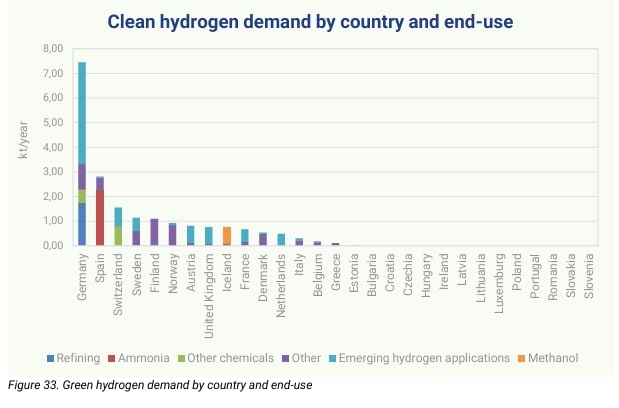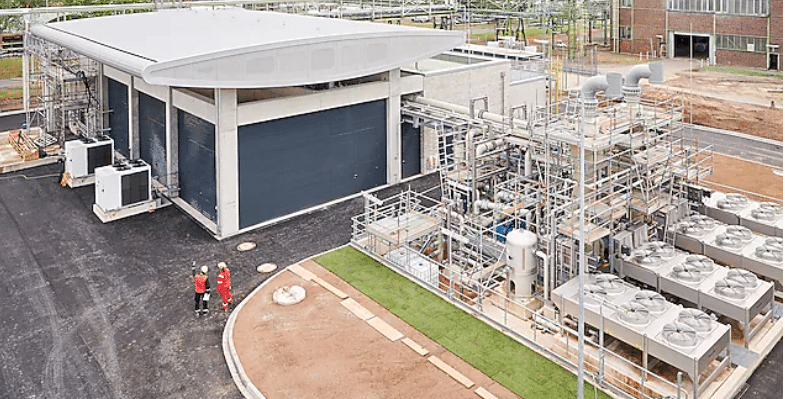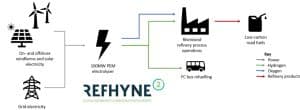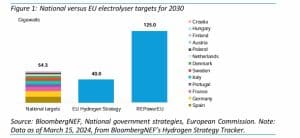In an exciting development in the renewable energy space, Shell is set to install a 100MW renewable hydrogen electrolyzer at its Energy and Chemicals Park Rheinland in Germany. This electrolyzer will generate up to 44,000 kilograms of green hydrogen daily using renewable energy. The project, designed to help reduce the site’s carbon footprint, is expected to start operations in 2027.
Unlocking Shell’s Massive Green Hydrogen Project: The REFHYNE II
The REFHYNE II project is the outcome of the successful execution of the original REFHYNE initiative. The new phase, funded by the European Climate, Infrastructure, and Environment Executive Agency (CINEA), aims to scale up Europe’s largest Proton-Exchange Membrane electrolyzer from 10 megawatts to a massive 100 megawatts. Notably, it aims to produce ~ 15,000 tons of green hydrogen annually.
As mentioned before, it will be installed at Shell’s Rheinland Energy and Chemicals Plant in Germany. The electrolyzer will produce green hydrogen and oxygen from a renewable energy source. This green hydrogen will then be integrated into the existing refinery systems to help reduce emissions from refinery operations.
source: REFHYNE
REFHYNE II: A Strategic Investment in Green Hydrogen
REFHYNE II benefits from supportive policies, such as the EU’s binding renewable hydrogen targets and Germany’s regulatory framework. Additionally, the project has received backing from the EU’s Horizon 2020 research and innovation program. This investment aligns with Shell’s goal to transform its Energy and Chemicals Parks into lower-carbon product sources.
Shell’s Downstream, Renewables and Energy Solutions Director Huibert Vigeveno noted,
“Today’s announcement marks an important milestone in delivering our strategy of more value with less emissions. Investing in REFHYNE II is a visible demonstration of our commitment to the hydrogen economy, which will play an important role in helping to decarbonise Shell’s operations and customer products.”
Noted in Shell’s press release, the company’s key partners in REFHYNE II include ITM Power (Trading) Ltd, ITM Power Germany GmbH, Linde GmbH, TECNALIA, ETM, SINTEF AS, and CONCAWE. Shell anticipates that the hydrogen produced will meet the EU’s renewable fuels of non-biological origin (RFNBO) standards. It has further elaborated that the REFHYNE II project will fit within Shell’s cash capital expenditure plans and surpass the internal rate of return (IRR) targets for its Renewables & Energy Solutions division. This was highlighted during last year’s Capital Markets Day organized by Shell.
Shell’s Bold Investments in Green Hydrogen
Greg Joiner, Executive Vice President of Shell Energy said,
“Shell’s commitment to renewable generation projects creates a path toward a sustainable future, where innovation and clean energy come together to power a brighter world. Across Europe through these renewable developments and further third-party offtake agreements, Shell Energy is supporting businesses to progress the energy transition by providing expertise and a range of renewable power solutions and bespoke offers.”
Shell Nederland and Shell Overseas Investments, subsidiaries of Shell plc, have decided to build Europe’s largest renewable hydrogen plant, Holland Hydrogen I. It will begin operations next year at the Rotterdam port. The 200 MW electrolyzer will produce up to 60,000 kilograms of renewable hydrogen daily. Additionally, the plant will use power from the offshore wind farm Hollandse Kust which is partially owned by Shell. The green hydrogen will decarbonize the Shell Energy and Chemicals Park Rotterdam, the key manufacturing hubs for petrol, diesel, and jet fuel.
Notably, Shell has always been a trendsetter in the green hydrogen space. In 2022, Shell and Kansai Electric Power collaborated on liquid hydrogen (LH2) supply chains to decarbonize their businesses Their partnership involved producing decarbonized hydrogen, deploying Shell’s liquefaction and storage technology, and using the hydrogen at Kansai, Japan’s thermal power plants.
Manufacturing green hydrogen is playing a pivotal role in Shell’s energy transition strategy supporting it to reach net-zero emissions by 2050. No wonder, this has marked a significant step toward a sustainable future.
Will the EU Meet its 2030 Hydrogen Goals?
In 2022 green hydrogen got a whole new perspective with a wide range of uses. It was being used in steel production, mobility, natural gas blending, e-fuels, and heating. Thus, 41% of Europe’s clean hydrogen demand, amounting to 8.09 kt, came from these new hydrogen uses.
With Europe witnessing a rise in green hydrogen applications, the demand for it also grew. For instance, the Netherlands, the UK, and Austria rely on these applications for 100%, 90%, and 86% of their hydrogen consumption, respectively. In Estonia, it’s 100%, while in Switzerland, it’s 51%. Moreover, specific industries lead the demand in various countries. Germany’s refining sector accounts for 23%, Spain’s ammonia production makes up 80%, Iceland’s methanol production is at 90%, and Austria’s steel industry dominates at 83%. Check out the detailed report here: The EU hydrogen market landscape

Furthermore, the European Roundtable on Climate Change and Sustainable Transition aka ERCST’s latest hydrogen report revealed that Europe has etched a significant mark in the low-carbon hydrogen market. It is fueled by ambitious targets and government incentives.
-
The EU adopted a hydrogen strategy in 2020, aiming to install 6GW of electrolyzers by 2024 and 40GW by 2030.
The REPowerEU plan, introduced in 2022 to reduce reliance on Russian natural gas, set even higher goals. It targets 20 MTs of renewable hydrogen use by 2030, with 50% from domestic production. BloombergNEF estimates that meeting this domestic target requires 125GW of electrolyzer capacity, which is 3x of its 2030 target.
EU Member States have also set their electrolyzer targets separately. It totals to 54.3GW by 2030. These national goals align with the EU’s hydrogen strategy but fall short of the REPowerEU target. However, BloombergNEF forecasts that EU countries will deploy a maximum of 23GW by 2030, based on the ongoing projects and policies. On the downside, this study indicates that most countries may not meet their national electrolyzer goals.
Overall, with a solid investment backup, the REFHYNE 2 project will push innovation to its peak. Consequently, Shell’s experienced team will manage the major scale-up with precision, thereby advancing green hydrogen significantly to achieve the EU’s target.




